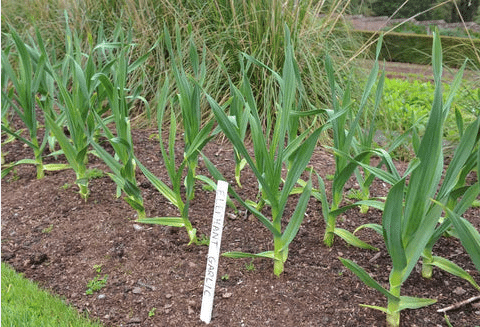Elephant garlic, with its impressive size and mild, intriguing flavor, is a joy to discover in the kitchen. But have you ever considered growing your own? Imagine harvesting those hefty bulbs from your own backyard! While not truly garlic (it’s actually a type of leek!), elephant garlic shares many similarities with its namesake, including a relatively easygoing nature when it comes to cultivation. Let’s dig into the optimal climate and soil conditions for growing elephant garlic successfully.
Climate Considerations: Finding the Sweet Spot for Elephant Garlic
Elephant garlic thrives in temperate climates with distinct seasons. It prefers a long growing season, similar to regular garlic, with cool, moist winters and warm, dry summers. Here’s a closer look:
- Temperature: Elephant garlic is a cool-weather crop. It prefers temperatures between 50-75°F (10-24°C) for optimal growth. While it can tolerate light frosts, prolonged freezing temperatures can damage the bulbs.
- Sunlight: Like most alliums, elephant garlic loves sunshine. Aim for a planting location that receives at least 6-8 hours of direct sunlight per day.
- Rainfall: Elephant garlic prefers moderate moisture throughout the growing season. While it can tolerate some drought, consistent watering is crucial, especially during bulb development.
Soil Matters: Creating the Perfect Bed for Your Elephant Garlic
Elephant garlic isn’t overly picky about soil type, but providing the right conditions will reward you with larger, more flavorful bulbs. Here’s what to keep in mind:
- Drainage is Key: Elephant garlic, like all alliums, is susceptible to rot in poorly drained soil. Choose a planting site with well-draining soil, or amend heavy clay soils with compost or other organic matter to improve drainage.
- Soil pH: Elephant garlic prefers slightly acidic to neutral soil, with a pH range of 6.0-7.0. You can test your soil pH using a home test kit and amend it accordingly with lime (to raise pH) or sulfur (to lower pH).
- Nutrient-Rich is Best: Elephant garlic is a heavy feeder and benefits from nutrient-rich soil. Before planting, amend the soil with compost, well-rotted manure, or a balanced organic fertilizer to provide the necessary nutrients for healthy growth.
Planting Elephant Garlic: Timing is Everything
Knowing when to plant elephant garlic is crucial for a successful harvest. Here’s a general guideline:

- Fall Planting (for most regions): In regions with cold winters, plant elephant garlic cloves in the fall, about 4-6 weeks before the first expected frost. This allows the cloves to develop roots before winter sets in and emerge early in the spring for a head start on the growing season.
- Spring Planting (for mild climates): In milder climates with mild winters, you can plant elephant garlic cloves in the spring, as soon as the ground can be worked. However, keep in mind that spring-planted elephant garlic may produce smaller bulbs compared to fall-planted cloves.
Planting Depth and Spacing: Giving Your Elephant Garlic Room to Grow
Proper planting depth and spacing are essential for healthy elephant garlic growth and development. Here’s what to do:
- Planting Depth: Plant elephant garlic cloves 2-3 inches deep, with the pointed end facing up.
- Spacing: Space cloves 6-8 inches apart within rows, and leave 12-18 inches between rows to allow for ample air circulation and easy access for weeding.
Caring for Your Elephant Garlic: Nurturing Growth Throughout the Season
Once your elephant garlic is planted, a little TLC goes a long way in ensuring a bountiful harvest. Here are some essential care tips:
- Watering: Water your elephant garlic deeply and consistently, especially during dry periods. Aim to keep the soil evenly moist but not waterlogged.
- Mulching: Apply a 2-3 inch layer of organic mulch, such as straw or shredded leaves, around your elephant garlic plants. Mulch helps retain soil moisture, suppress weeds, and regulate soil temperature.
- Fertilizing: Elephant garlic benefits from a mid-season side-dressing of fertilizer. Apply a balanced organic fertilizer or compost tea around the base of the plants when they are about 6 inches tall.
- Pest and Disease Control: Elephant garlic is relatively pest-free, but keep an eye out for common garden pests like aphids and slugs. You can deter pests by using row covers, hand-picking, or applying insecticidal soap.
Harvesting Your Elephant Garlic: Reaping the Rewards of Your Labor
Knowing when to harvest your elephant garlic is key to enjoying its full flavor and ensuring proper storage. Here’s what to look for:
- Foliage Clues: As elephant garlic bulbs mature, the lower leaves will begin to yellow and brown. This is a good indication that harvest time is approaching.
- Bulb Size: Gently brush away some soil from the base of a few plants to check the bulb size. Elephant garlic bulbs are ready to harvest when they reach a desirable size, typically around 4-6 inches in diameter.
- Harvesting Time: Most elephant garlic is ready to harvest in mid to late summer, about 9-10 months after planting.
Enjoying Your Homegrown Elephant Garlic: From Garden to Table
Once harvested, cure your elephant garlic by hanging the bulbs in a well-ventilated, shady location for 2-3 weeks. This allows the outer layers to dry and the flavor to mellow. Store cured elephant garlic bulbs in a cool, dry place, where they can last for several months.
Growing your own elephant garlic is a rewarding experience that allows you to enjoy this unique allium’s fresh, flavorful bounty. By providing the right climate, soil conditions, and care, you can cultivate impressive elephant garlic bulbs that will elevate your culinary creations.
Frequently Asked Questions: Addressing Your Elephant Garlic Growing Queries
1. Can I grow elephant garlic in containers?
Absolutely! Elephant garlic grows well in containers, making it an excellent option for gardeners with limited space. Choose a container that’s at least 12 inches wide and deep to provide ample room for root development. Use a well-draining potting mix and follow the same planting and care guidelines as you would for in-ground planting.
2. How do I know when my elephant garlic is ready to harvest?
Elephant garlic is typically ready to harvest in mid to late summer, about 9-10 months after planting. You’ll know it’s time when the lower leaves begin to yellow and brown. Gently brush away some soil to check the bulb size – they should be around 4-6 inches in diameter.
3. What are the best ways to store elephant garlic?
After harvesting, cure your elephant garlic by hanging the bulbs in a well-ventilated, shady location for 2-3 weeks. Once cured, store the bulbs in a cool, dry place, where they can last for several months. Avoid storing elephant garlic in the refrigerator, as the moisture can cause it to sprout.
4. Can I eat the scapes of elephant garlic?
Unlike regular garlic, elephant garlic rarely produces scapes (flower stalks). So, while you won’t be enjoying elephant garlic scape pesto, you can savor the bulbs’ unique flavor in countless other ways.
5. What are some common problems to watch out for when growing elephant garlic?
Elephant garlic is generally a low-maintenance crop, but keep an eye out for pests like aphids and slugs. Ensure good drainage to prevent bulb rot, and avoid overwatering, which can lead to fungal diseases.
Discover the Astonishing Benefits and Uses of This Giant Bulb,click here.
